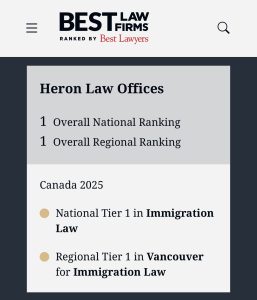Continuing a series of a blogs Vancouver Immigration Blog and Heron Law Offices have collaborated on breaking down the data we have received from IRCC with respect to judicially reviewed decisions.
Mandamus, especially perceived spike in mandamus cases, has been front and centre of a lot of recent discussion in the space of judicial review. It seems from practice that out of the few mandamus cases that end up in decision, many more are filed. This is also an area where there is concern of possible use of generative AI to essentially replicate memorandums and repeat arguments, given the somewhat historically stable (although recently challenged) legal test.
For those who need a quick recap on the writ of mandamus as a judicial remedy, I encourage you to read this piece from my mentor, Mario Bellissimo here from a few years back.
Going back to the statistics – if the numbers show us that mandamus cases are largely being settled and not going to hearing or resulting in lower leave rate dismissals, makes this area a ripe place for the Court to examine a different streamline or process, or perhaps to encourage policy that would keep these cases out of the Courts.
On the flipside, if the numbers seem normal enough and just part of the regular course of litigation – perhaps there needs to be less policy intervention at the Court level and the attention should solely be placed on trying to advocate IRCC to bring down processing times to more equitable levels.
Let’s begin our study.
Total Litigation Counts – Mandamus
First, let’s take a look at the summary of litigation count.
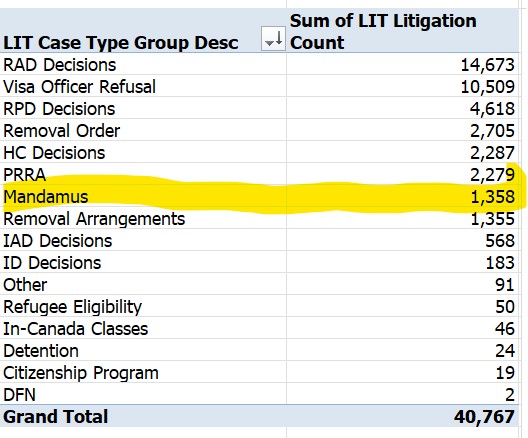
If we are looking at pure numbers, mandamus was the seventh-most litigated immigration matter coming in 1,358. Given what comes before and what comes after, initially one might be quite surprised that mandamus is not ‘higher’ up the list.
However, looking at a year to year count of total mandamus JRs we get a different picture.
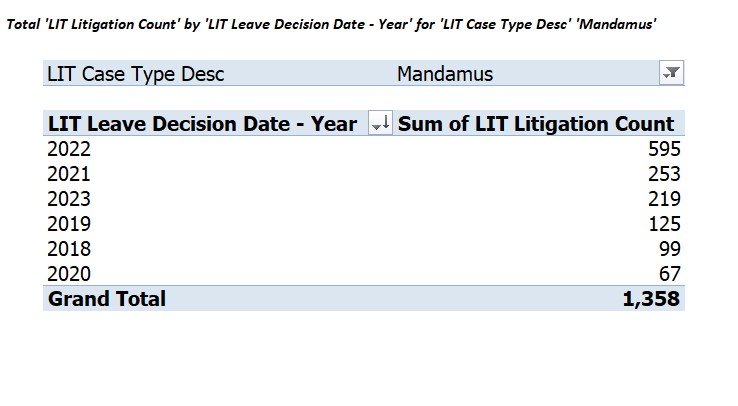
In fact, in the first three years we have numbers for mandamus applications were not as plentiful. Consider also 2023 is only January – June (six months) so the actual numbers this year can be projected to be in the mid-400 range. The anomaly seems to be the 2020 year where only 67 mandamus cases were filed in the Federal Court quite possibly related to the COVID-19 pandemic and travel restrictions at the time. However, the direct impact of that time can be seen in the years following, especially 2022.
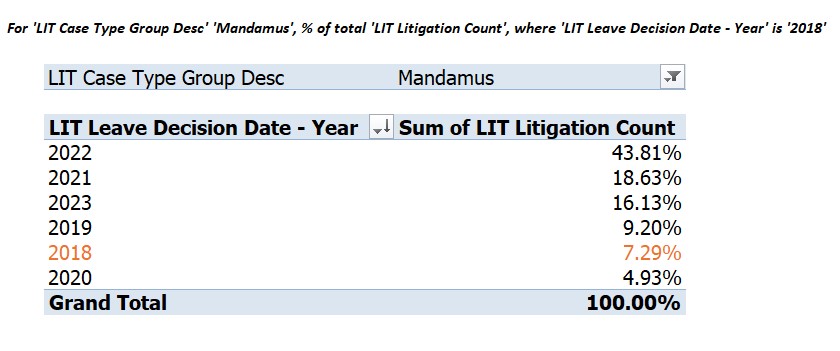
You can see from the breakdown that the last three years (even with 2023 stats being only YTD to June) make up over 80% of the total mandamus JR litigation count.
Data Limitations
Here we have to speak about the limitation of the data. What we received from IRCC categorizes only that it is a mandamus case, but does not tell us what the underlying decision is that mandamus is being filed for. Furthermore, we know in practice that that mandamus is also tacked on as a remedy to judicial reviews of officer decisions, for which presumably the stats do not track.
Mandamus Judicial Review Outcomes
One area we are able to take a closer look at is judicial review outcomes over the years and as an aggregate.
Let’s start with overall over the past five years:
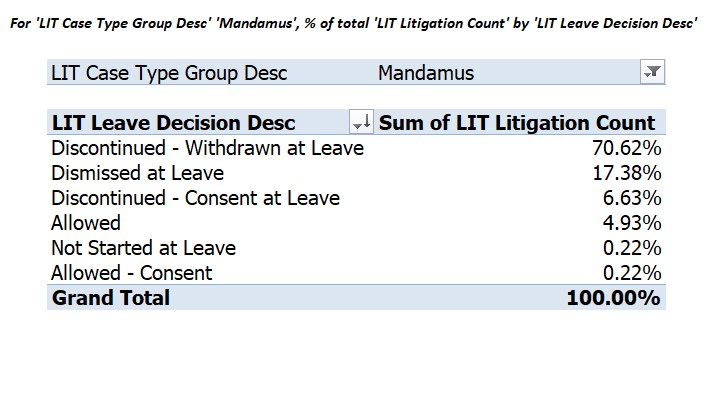
Overwhelmingly, over the past five years mandamus cases have been Discontinued – Withdrawn at Leave. This outcome is not surprisingly to many of us who practice in the space and see that the mandamus filing itself (if not the demand letter earlier) start triggering file movement which then leads clients to be satisfied there is movement. They may get a procedural fairness or request letter, which then eliminates their need for a quick final decision switching gears to needing time to respond to the allegation. Dismissal rates for mandamus are much lower than for other areas. I am sharing again the overall outcomes for all JR cases table for reference.

Let’s take a look now at the year to year outcomes for mandamus judicial reviews starting with 2018, the first year we have data for.
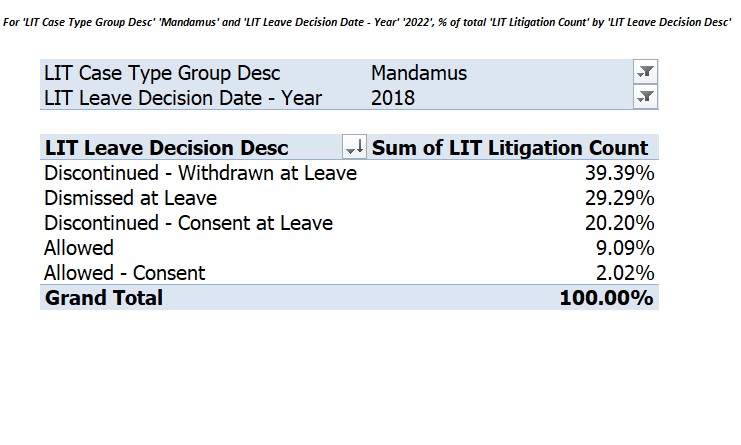
As you can see, the 99 cases this year saw a large number discontinued – withdrawn at leave, but definitely a more egalitarian split between cases that were also consented on at leave, and a higher leave dismissal rate.
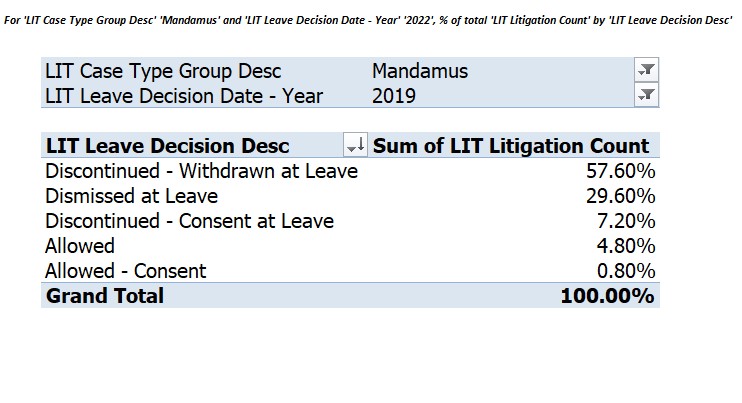
In 2019, the Discontinued – Withdrawn at Leave rate jumped, but the leave dismissal rate decreased. You saw far fewer consents out of the 125 cases this year.
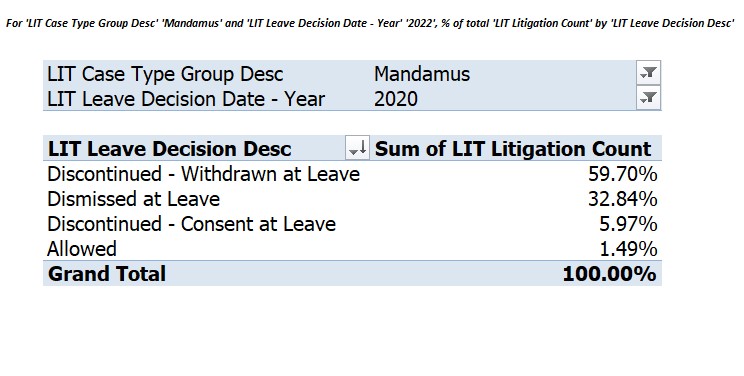
2020 saw very consistent stats also, a slightly higher leave dismissal rate but overall consistency out of the five-year low 67 cases.
Now things get interesting with 2021.
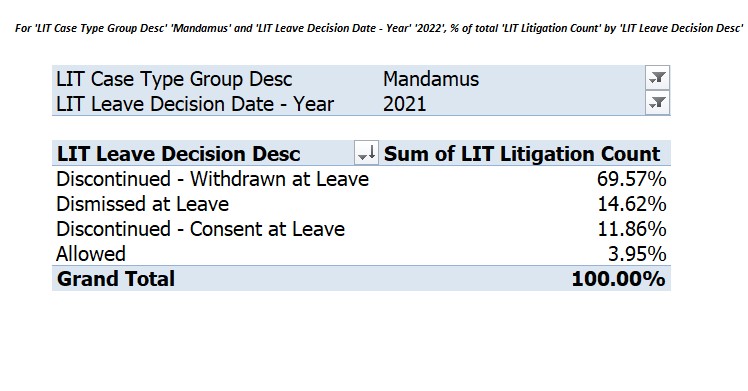
We have a 10% jump in the Discontinued – Withdrawn at Leave for the 253 cases this year and a corresponding 18% drop in the Dismissed at Leave rate.
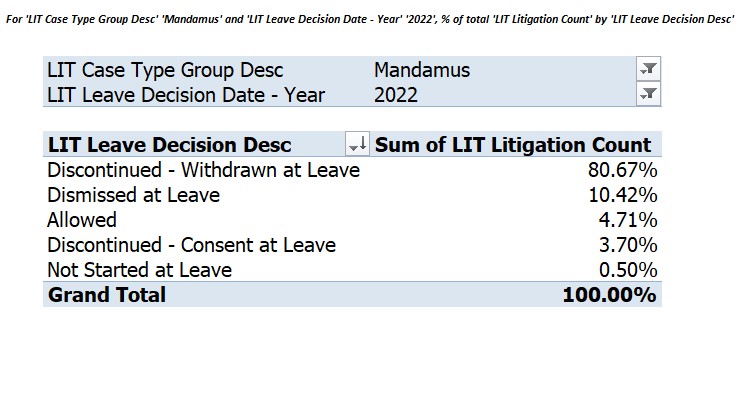
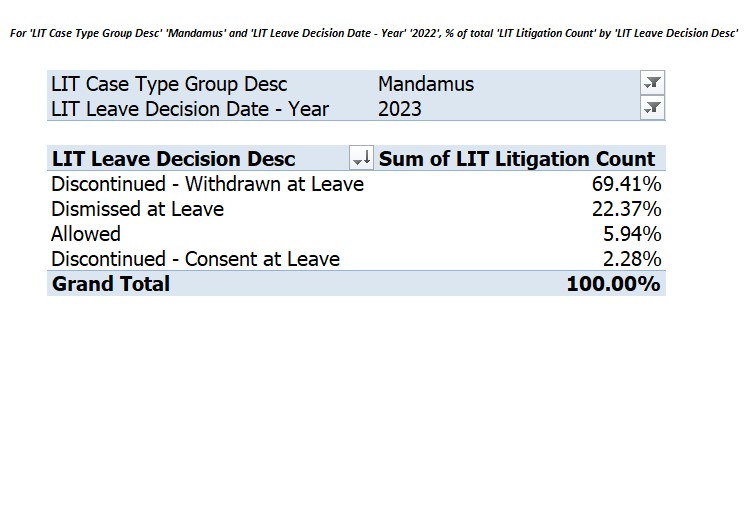
2023 has seen a bit of a regression back to norm with the 219 cases to date reflecting closely both to 2021 numbers and the overall average for the five-year period.
Breakdown by Country of Citizenship
We are also taking a look at breakdown of mandamus by country of citizenship, i.e. which citizens are filing mandamus. I actually was able to cite to these stats in an interview with the CBC today which hopefully will be shared for their piece.
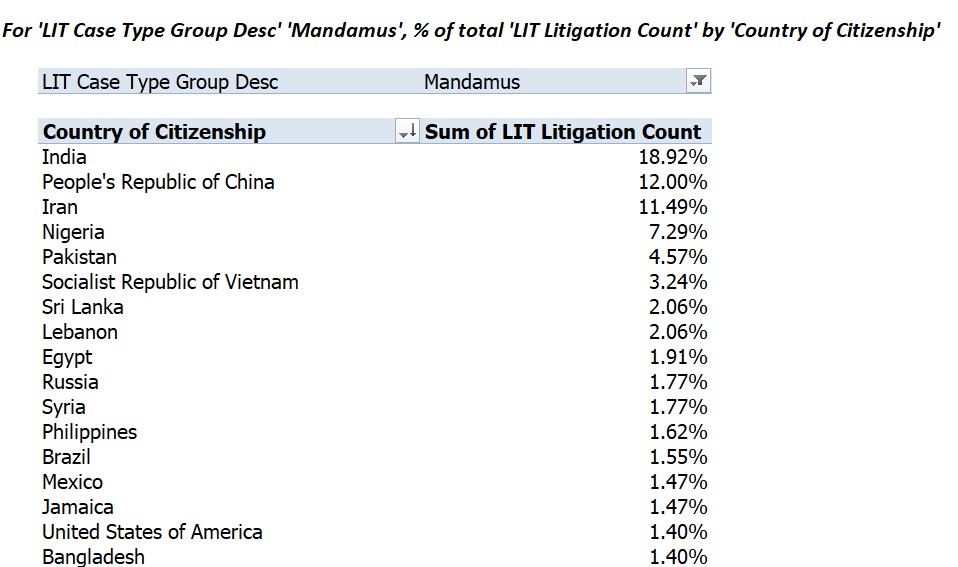
As you can see, between India, PRC, Iran, Nigeria, and Pakistan you have more than 50% of all mandamus JRs filed. Countries like India (which has the largest number of Applicants), Iran (where we know the challenges of getting files out of Ankara exist and background/security checks), and China (where geopolitical challenges and security checks have arisen). More surprisingly to me are Nigeria, Pakistan, Vietnam, and especially countries like Sri Lanka and Lebanon that don’t factor into our high volume – more mandamus theory.
For those curious the raw numbers are below:
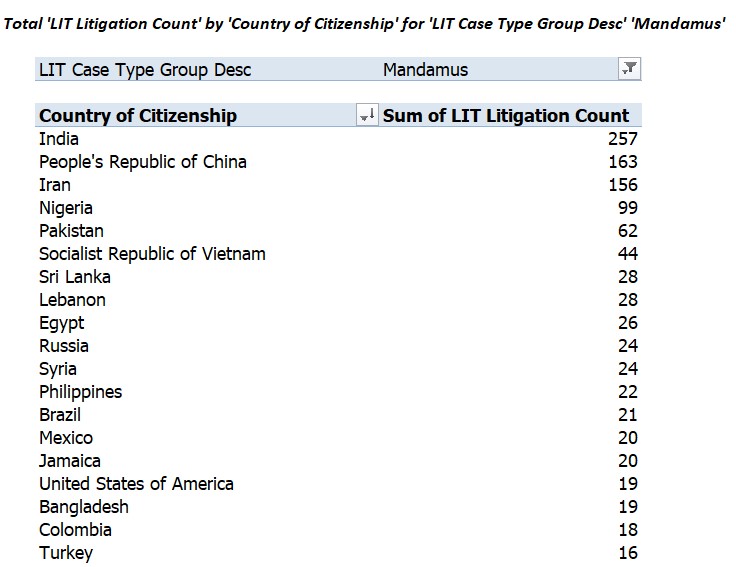
Taking a look at any discrepancies with Mandamus outcomes by Country of Citizenship, I was only able to extract by total numbers rather than year (if anybody has advanced Excel skills please reach out!). Please see below for the top countries mentioned above:

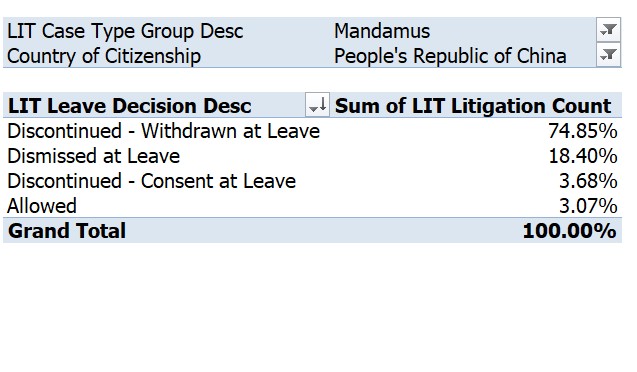
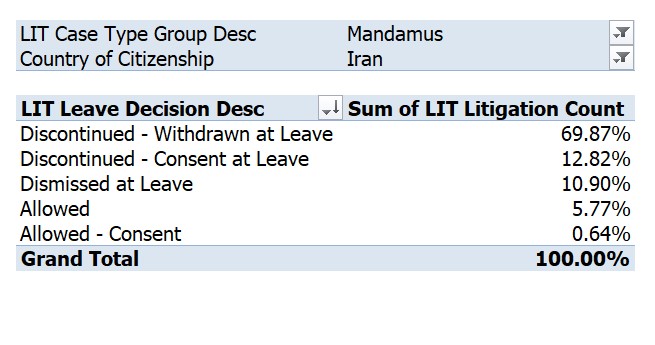
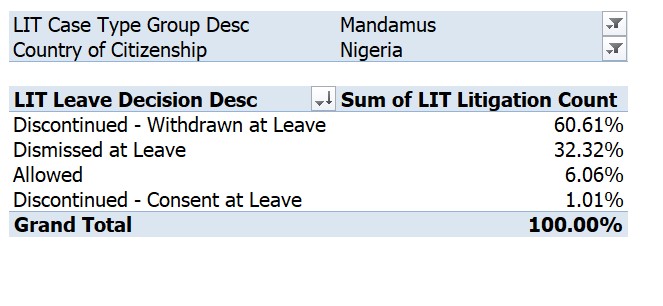
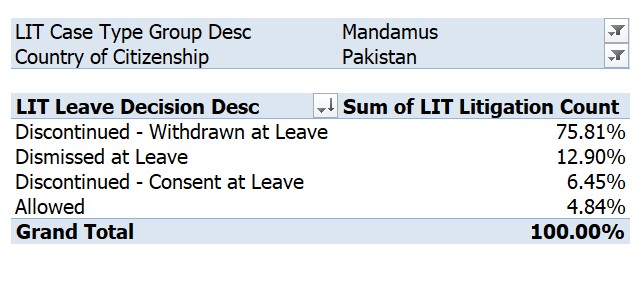


The major stats that stick out here are Nigeria and Vietnam. Nigeria, for having an above average 32.32% leave dismissal rate (which over my review of multiple areas seems to be a bit of a worrisome trend) and Vietnam for not having a single of the 44 cases go beyond the discontinuance stage.
Here is again where I would love to see stats on both the visa application types where mandamus is being filed, but also what visa office. Unfortunately, all we have is below:
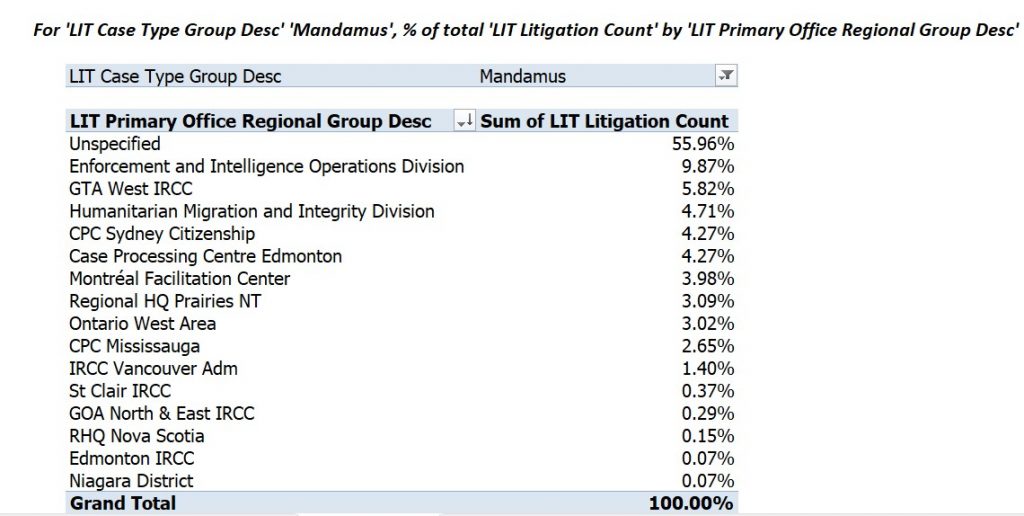
The unspecified largely represents the overseas visa offices, Case Processing Centre – Ottawa, Case Processing Centre – Edmonton (different than IRCC Edmonton). I would not be surprised if some of the Enforcement and Intelligence Operations Divisions ones were respect to Ministerial relief and complex admissibility cases that have dragged on (security screening cases for example).
Takeaways: Why is this Important?
Mandamus is important because it is the litmus test for delays and probably a good indicator for how busy the Court will be. Specific to mandamus this appears to be a subset of cases that have a very high consent rate, meaning these are cases where the time spent by registry clerks, lawyers for the applicant, Government lawyers could probably be reduced. These are cases that go up to leave and stop there – meaning Judges are called in but ultimately not asked to render many final decisions. For those considering how to reduce the Court’s backlogs, reducing mandamus might be a starting point.
From a critical perspective, you also have the largest number of mandamus cases being filed by Applicants from a mix of both high-volume visa office applicants (skewed a bit as many decisions now made in Canada), but also from traditionally non-high volume countries. Does that suggest files are being stuck at local Visa Offices? Is this the consequence of geopolitical concerns leading to longer security screening cases that trigger mandamus?
Lots of interesting and fascinating questions to ponder as we move forward.


